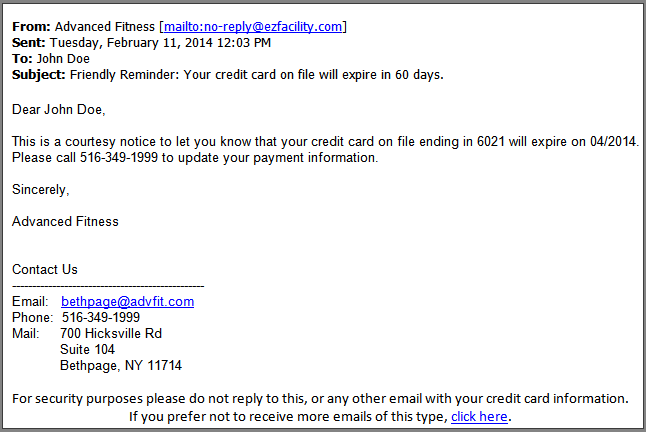Towson University, in the Baltimore suburb of Towson, Maryland, recently announced a $34 million expansion of its recreation center.
The expansion will add 90,000 square feet to the center, known as Burdick Hall. It will include two multipurpose athletic courts, group exercise studios, and a three-lane indoor running track. The courts will be used for indoor soccer and lacrosse, and the studios will serve cycling classes, martial arts, and personal training. As it exists now, Burdick Hall contains a swimming pool, basketball courts, and a 33-foot indoor climbing wall.
“It’s always gratifying to see a university commit to improving its athletic facilities,” said Eric Willin, COO of EZFacility, a sports facility management software developer in Woodbury, New York. “Doing so sends a message to students, faculty, staff, and alumni that sports and fitness are of primary importance, and it gives members of the school’s community an opportunity to work out or compete to the limits of their abilities. This addition is sure to enhance Townson’s athletics a great deal.”
Towson University fields 19 NCAA Division I varsity teams that compete in the Colonial Athletic Association. In 2013, it constructed a 5,200-seat, state-of-the-art sports arena, which hosts the school’s basketball, gymnastics, and volleyball team. The university also boasts the Baltimore metro area’s third-largest outdoor stadium and a freestanding baseball park.
Author: ezfacility
Colorado Town May Enter Public-Private Partnership for Synthetic Snow Facility
The town of Castle Rock, Colorado, recently signed a letter of intent to enter into a public-private partnership with Weston Solutions, Inc., for the creation of Castle Rock Year-Round Snow Sports Center, a $5.5 million synthetic snow facility.
If constructed, the facility would feature a 107,000-square foot skiing surface, a bunny slope, a tubing run, a downhill mountain bike course, a lodge with restaurant and bar, and a dedicated parking center. The snow-like, synthetic material SnowFlex, tailored to suit Colorado’s climate, would cover the slopes.
Shawn Temple, Development Director of Weston Solutions, said in a statement, “This public-private partnership will serve as a sustainable economic driver for the local community while increasing the town’s tax base and providing a legacy of smart planning that will serve the needs of the community for generations to come.”
There has been some question about the viability of a synthetic snow facility in a state known for its skiing. “If the facility proposed by Weston Solutions is approved by the town, it’ll be interesting to monitor how it does in an area saturated with real snow sports activities,” said Eric Willin, COO of EZFacility, a sports facility management software developer in Woodbury, New York. “Chances are it would thrive. Year-round skiing would introduce new people to the sport and provide daily training, better preparing consumers for actual snow. And consumers wouldn’t have to drive hours outside of Denver for skiing — it would be available 30 to 45 minutes from the city center. That will be a draw.”
The town’s letter of intent allows Weston Solutions to research the feasibility of building the facility. Town council members will review the company’s proposals every six months for up to two years; if a plan for financing the project looks viable, the council will vote on it.

Get Fit with Exercise Snacking
Have you heard the latest? Snacking is good for you. Not food snacking—exercise snacking. Researchers in New Zealand recently conducted a study that showed that multiple, brief portions of exercise in a single day—“exercise snacks,” the researchers dubbed them—may control blood sugar better than a single, continuous workout. The study was conducted on men and women with insulin resistance, a common precursor of Type 2 diabetes. Though, the news is relevant to anyone who wants to stay healthy by keeping blood sugar under control. In the study, participants who exercised for 12 minutes before breakfast, 12 before lunch, and 12 before dinner had far lower blood-sugar levels after dinner than those who exercised only once in a day, for 30 minutes before dinner. They also kept their blood-sugar levels lower for longer—over 24 hours as opposed to less than a day.
What does this mean for health clubs, gyms, fitness centers, and exercise boutiques? Well, you need to be prepared to serve members and clients who are looking to get to your facility three times a day. Also, if you want to help your members and clients reach their health-related goals (and you do, because their success is your success), you should probably think about how to encourage those who aren’t necessarily looking to get there three times a day to do so — and, let’s face it, many of them most likely struggle to get there once a day. Scientists have long argued that shorter, more frequent bursts of exercise are more beneficial than long, continuous spells. As the body of research supporting this hypothesis grows, more and more people will be demanding — and needing — to fit this new way of working out into their daily routines. This is especially true because, as researchers of the New Zealand study discovered, the blood-sugar benefits (and it remains to be seen which other benefits) are strongest when the exercise snacks consist of high intensity interval training. For most people, such training is much easier to do at a facility, with trainers and functional fitness equipment, than at home.
Here are a few ideas to consider:
1) Create a new three-times-a-day program. First, be sure to spread the word about the findings of the New Zealand study (and other studies that show the benefits of exercise snacking). Then, establish a structured program to help people get started. Designate a core group of trainers to work with the three-times-a-day-ers: They’ll have to work hard to motivate their clients to come before breakfast, lunch, and dinner. At the same time, they’ll need to plan out careful twelve-minute exercise sessions, preferably high-intensity interval routines.
2) Everything’s easier with incentives. What discounts, rewards, or deals can you offer your members for trying out a new three-times-a-day program? Can you provide a day pass that will allow them fast-track entry each time, or a free smoothie from the juice bar after they complete their third workout? Can you give a free month to members who manage to make it to your facility three times a day, three days a week, for one month? Or maybe you can offer a month at half price for anyone who comes in three times a day with a friend at least twice in one month. The possible variations are limited only by your imagination.
3) If your facility has the capacity to serve food, consider providing three-times-a-day-ers with vouchers for at least one meal on their exercise days. This might make it easier for them to contemplate the logistics of coming to and leaving your facility three times in one day. They might, for example, come before breakfast, head to work, come before lunch and then stay and have lunch, and come again before dinner.
4) If it’s feasible, consider offering three-times-a-day classes in a couple of satellite locations in addition to your facility (maybe there’s an empty warehouse somewhere on the other side of town?). That way, members who live or work further away from your facility have a choice in where to go, and choices make for convenience.
As the trend increases and the demand for facilities to accommodate for more frequent, briefer sessions grows, health clubs and other fitness venues will learn what works and what doesn’t. Now is the time to get started — put yourself at the forefront of the exercise snack trend, and you’ll find yourself the leader of a pack before long.

The Right Hire For Your Gym
If you’re a fan of reality television, or even if you’re not, you have probably heard about the recent episode of Inside Job that featured New York’s David Barton Gym. Inside Job’s premise is that a company seeking to fill a position agrees to let the show’s producers select three candidates. Those candidates live together for a week and undertake challenges that supposedly reveal their worthiness for the job. A fourth person also lives in the house, someone already employed by the company who presents himself or herself as another candidate for the position. That person is the insider, reporting back to the CEO about the candidates and choosing one of them to recommend.
Well, that’s one way to hire an employee. For those of us who don’t have the opportunity to get to know job candidates quite so intimately before we hire them, we need other approaches. Since so many staff positions at a fitness center or sports facility involve direct interaction with members and clients, it’s crucial to hire carefully. Moreover, hiring is an expensive process; you want to get a good return on your investment.
What can you do to ensure you’re hiring well? To begin with, craft an excellent, clear, and precise job description. The more specific your description, and the more explicitly you define what you’re looking for, the better your chances of finding appropriate candidates. If you need a marketing person with social media experience, don’t just put, “Five years marketing experience”. It’s better to write, “Experienced marketing professional with social media expertise.” Also, be sure to stick in a few words that convey the sort of work ethic you’re looking for. If you want to scare off potential loafers, then change that wording to “Dedicated, experienced marketing professional with social media experience, a can-do attitude, and the willingness to stick it out when things get tough.”
Once you’ve collected your applications and narrowed the pool down to a handful of candidates, line up your interviews. Let me stress on the word “handful”: At this point, you don’t want to bring in too many people. Start with your top three or four choices; if you can’t find what you’re looking for among them, you can always call in others.
No doubt you’ve conducted interviews before, so you know the drill. Still, there’s one thing that’s easy to forget: Interviews are not effective if you’re focusing only on the science behind them — the questions you should and shouldn’t ask, how you read a résumé, what answers a candidate gives to your questions. More effective is to focus on the art of interviewing. This means paying attention to how a candidate answers your questions more than what they say. Did you get an answer — but not to the question you asked? Were there inconsistencies in the candidate’s replies? What was the candidate’s body language saying, what were the unconscious reactions and gestures? These will help you better understand who the person is (rather than just what he or she has done).
Once you make an offer, be prepared to negotiate. Any candidate worth hiring is probably going to come to you with a counter-offer. Remain open to the offer. Often, it reflects what the potential employee truly thinks he or she is worth. You might not be able to meet the counter-offer, but you might gain some clues about what alternative offers the candidate might be willing to accept. If you really want the person, you’ll have to find a way to make him or her happy.
Which brings me to my final point: Keep your employees happy. The gym and sports industries by nature face high turnover (how about a reality TV show that addresses that fact?). When you’ve invested the time, money, and energy to hire the right candidate, you want to do everything you can to make sure he or she stays. Create an open, warm workplace that makes relationship-building a priority. Recognize and reward good work. Consider perks such as tuition reimbursement, free lunches, and employee-of-the-month programs. The investment in human capital is worth it.
Acquisition of Two New Clubs Indicates Growth for California Family Fitness
California Family Fitness, Orangevale, CA, acquired two new clubs this month. The company took over Alhambra Athletic Club and Riverside Athletic Club, in Sacramento, CA, renaming them California Family Fitness Midtown Club and California Family Fitness Greenhaven Club, respectively.
The club also announced the opening of a new 32,000-square-foot downtown Sacramento club, bringing its total number of clubs to 18.
“It’s exciting to see a small club growing so rapidly,” said NAME TK, TITLE TK, of EZFacility, a health club management software developer in Woodbury, New York. “Such expansion shows that there’s room for development in the industry, and that, even in a tight economy, facilities can flourish.”
Randy Karr, president of California Family Fitness, said in a statement, “California Family Fitness is excited to expand our footprint and serve a new member base in the heart of Sacramento. We are committed to providing our members with state-of-the-art equipment, popular programs, and activities in a convenient, fun, and friendly environment.”
Last year, the company’s founders, Larry Gury and Russ Kuhn, sold almost $100 million worth of their real estate portfolio, aiming to use the money from the sale to build more clubs.

Helping Your Members Connect
Every weekday morning, my sister-in-law heads to a functional fitness center and undergoes a grueling routine involving kettlebells, ropes, medicine balls, and heavy chains. The center is located in a small warehouse with a homegrown feel. There’s one instructor and a small number of regulars for each time slot; it’s the kind of place where the instructor greets everyone by name and asks about their kids and pets. My sister-in-law took me to a class recently. When I arrived, she introduced me to each person there, and they welcomed me so warmly that I felt I’d known them all for years.
The workout that followed made me want to lie in bed for three days and moan feebly, but I had a great time while I was doing it. It was great partly because functional fitness is just plain fun and the instructor was wonderful—but I know the main reason it was great, was that I felt instantly comfortable around all of those people. I felt accepted; I felt both gently teased (when I collapsed after the ten-thousandth burpee) and brilliantly supported (when I discovered a natural flair for kettlebell action); I felt a genuine interest in all of my classmates, and it was clear that feeling was mutual. I left with a whole new set of friends.
My sister-in-law lives far away, so I can’t join the class, but I know that if I could, I would (despite its tortuous aspects). There’s one simple reason why I would: to be a part of that community. Anthropologists and social scientists have long known that human beings function best when they function within a community. We have our ideas about independence and autonomy, but when it comes to basic questions of survival, or just to getting through each day—or, say, to getting through a workout—we need to have others around us, and we need to feel some connection to those others.
For owners of gyms, fitness centers, training facilities, and health clubs, these facts are crucial to running a sound business. If you build a supportive, intimate community, you’re much more likely to both retain members and find new ones. So where do you begin?
1) Introduce members to one another. This one is simple, but it works, perhaps even better than anything else. I don’t mean just play icebreaker games at the start of a class; I mean make personal introductions based on your knowledge of your clients. If a new member who is a schoolteacher joins, bring her over to the schoolteacher who’s been working out at your facility for years and get them talking. Of course, you can’t facilitate connections on this level without first knowing—or ensuring that your staff knows—members personally and thoroughly. Getting to know them personally and thoroughly takes a great investment of time and energy, but it’s one of the most worthwhile investments you can make. Members will feel valued, and their positive feelings will translate into referrals, loyalty, and longevity.
2) Form clubs to address specialty interests. Find out what your members are interested in doing outside of your facility (you can use surveys, registration forms, or just personal chats for this), and see what happens if you form a club around that activity. Outdoor biking, bellydancing, macrobiotic cooking — whatever it is, you can get things started, and you don’t have to do much else. Put up a sign-up sheet, and let the members themselves take care of the rest. They’ll form personal connections and you’ll benefit.
3) Get social. I’m talking about two kinds of social here: real and virtual. On the real side of things, host cocktail hours (or juice bar hours), get-togethers, and meet-and-mingle events. Match members up for training sessions. Hold talks and seminars. On the virtual side, welcome new members to Facebook, offer incentives to members who post to your Facebook page or comment on posts you put up, create a Facebook group that members can join in order to stay connected. Explore other forms of social media too. Again, your members will form a valuable community; you’ll reap the rewards.
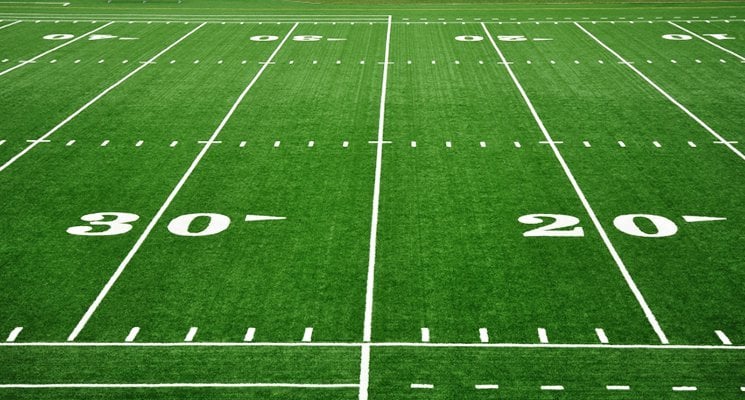
5 Steps to Safeguard Your Sports Facility Against Liability
Ever had an athlete twist an ankle on your field, or worse: break a leg, dislocate a shoulder, or sustain a head injury? Ever had someone run into a brick wall? I’m serious here — at one football field, a brick wall was placed just beyond the end zone, and a player ran full speed into it. Be glad you weren’t the owner of that field when the question of liability arose — because, when you run a sports facility with a field, the question of liability always arises. You have to be vigilant about it, and take constant measures to both protect players from injury and yourself from litigation. What can you do?
- Start with common sense. There are no published industrywide standards for all aspects of sports fields, but there are generally accepted expectations. Is your playing field level? Is it free of debris, holes, depressions, and other potential safety hazards, such as loose seams and worn patches? Is there a risk of rocks rising to the surface, and is the field playable when wet? Your field maintenance efforts should focus first on safety, while your common sense should guide you in terms of what is safe and what isn’t.
- Next, take a look at your field as if you’ve never seen it before. If there are liability issues, you’ve probably become so accustomed to seeing them that you don’t really notice them anymore. Take the brick wall, for instance: Any field manager who has stopped to think about it would have realized the danger. However, it’s easy to not think about things when you’ve got a routine and a checklist of tasks to accomplish. Step onto your field and look around. Are there poorly placed walls? Are there ridges or lips on the field?
If it’s an expanded field, such as a soccer field, is there sufficient space for athletes to slide without hitting fences? Is there room to comply with American Disability Act requirements? See everything as if it is for the first time and make assessments. If you’re too busy to consider all of the potential problems, or are just too familiar with your field to be able to see it with a fresh eye, don’t hesitate to have an outside firm audit safety issues. If you don’t have the budget for an outside inspection, consider asking a fellow sports field manager to inspect your facility in exchange for you to inspect theirs. - Do your paperwork. Make sure you have contracts, insurance documents, and anything else you might need in place, in order to manage any financial and legal liability. If anything unfortunate ever does occur, you’ll need to have the paperwork ready on hand.
- Don’t delay. When you identify a potential problem, fix it right away. No, scratch that: First document it by noting the problem, how and when it was discovered, and what the strategy for resolution is. Then go ahead and fix it.
- Finally, after an issue has been discovered, documented, and dealt with, schedule regular re-inspection times (document your re-inspections!). Then take the time to analyze: Why did the problem occur in the first place? Could it lead to other problems? Are there ways to avoid such problems in the future? Remember, the best way to reduce risk is through prevention. This way, any time and resources you invest into large-scale improvements now will pay off for you down the road.

Addition of View Details Option on E-mail Campaign History Page and More!
In a world full of numbers it is easy to get lost in them. From what’s in your bank account to the number of clients that pass through your facility each day. Our last release featured the introduction of the Email Campaign History page, which, not only gives you the ability to see previously sent emails, but also allows you to report on their success or failures using numbers. With that in mind EZFacility’s Development Team has taken that concept one step further with the release of a “View Details” section of the Email Campaign History Page and more!
View Details- Email Campaign History
In the Email Campaign History section of your EZFacility account you will notice our newest feature – View Details. Our goal for adding the View Details section was to associate a name and purpose with email campaign results. This allows you to better understand and analyze the reach and depth of your campaign efforts.

Clicking into View Details will automatically display campaign result totals for a variety of industry standard email event types. These results can be broken down to include the email address of the recipient and an event time stamp that allows you to view statistics as they happen. You can also filter through campaign information using criteria such as email address and event type.
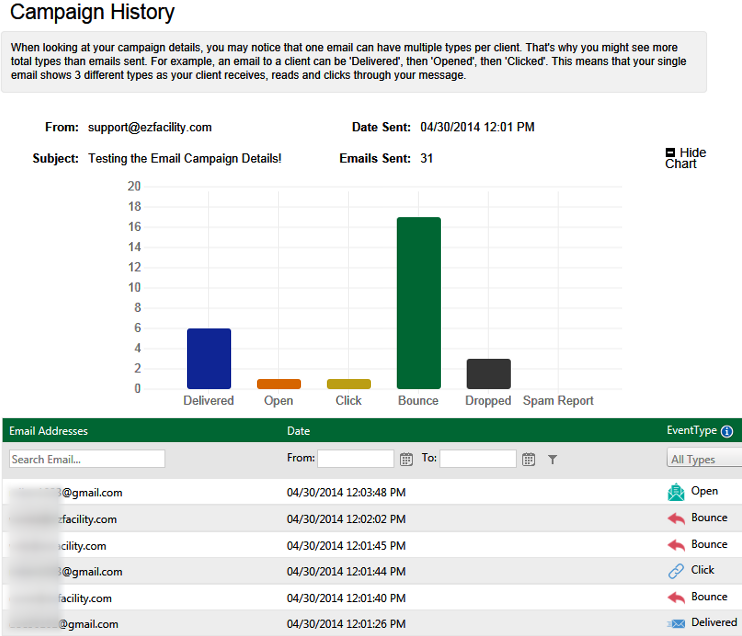
Email Results Recorded:
- Delivered: Message has been successfully delivered to the receiving server.
- Open: Recipient has opened the HTML message.
- Click: Recipient clicked on a link within the message.
- Bounce: Receiving server could not or would not accept message.
- Dropped: Recipients IP address has been added to the blacklist.
- Spam Report: Recipient marked message as spam.
Display Available Openings Remaining on an Online Registration Form
In an effort to make Online Registrations as efficient as possible, our latest release includes the ability to display the remaining openings available on an Online Registration Form. When your clients first view this page they will be met with the available openings remaining totals for creating new subgroups and individual registrations. For those clients who will be looking to register for a sub group, the sub-group openings will be displayed when viewing the list of subgroups.
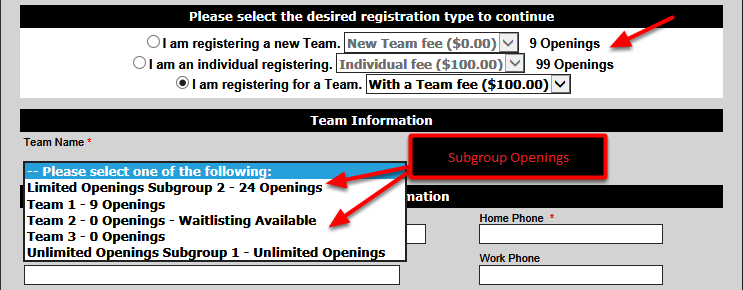
Note: The number of available openings remaining is based on the “Max. Individuals” and “Max. Subgroups” set in the group details.
Update to Our SPAM and Security Settings
With our latest release we have made an update to our SPAM and security settings. Now, when sending an email blast, the ‘From’ field will be changed from your facility or personal email address to services@mail.ezfacility.com, while still displaying the name of your facility at the top. Be assured however, that when a client replies to a sent email, it will be received by the user that sent the email blast and not EZFacility. This change is for security reasons, and is being implemented across the industry for SPAM prevention. Email providers such as Yahoo and AOL already require this change and are beginning to block emails that are sent ‘on behalf of’ another email address.
And More!
In addition to these changes, there were many additional updates included in this release. For more details, please visit out Release Notes page.

Establishing a YouTube Presence
YouTube is the second most used search engine in the world. The first is Google. When you consider the facts that (1) Google owns YouTube, (2) Google’s search engine algorithm weighs heavily the presence of videos on a website (in plain English: if you’ve got videos, your site will appear higher up in Google’s search results), and (3) videos are much more likely to go viral than text-only online content, the conclusion you should draw is obvious: Your facility can benefit from having a presence on YouTube.
But where to begin? Or, if you already have a selection of videos on YouTube, how to optimize? Don’t worry. There are some simple steps you can take to establish yourself in the YouTube universe.
First, if you haven’t already, create a YouTube channel for your facility. This takes seconds to do and allows you to build up a mass of users who subscribe to your account; it also lets you send emails to subscribers. Be sure to upload the videos you create to your channel.
Then consider the production value that’s right for you. Your videos do not have to be perfectly polished works of art; in fact, anything too polished could be off-putting. You want to keep them authentic, comfortable, and welcoming. You also want them to be cost-efficient. This means investing just enough resources to get your point across; you might be able to make a perfectly fine video with just a smartphone attached to a tripod accessory (just make sure you’re paying close attention to sound quality; if you invest in any sort of high-tech equipment, let it be a great microphone).
That said, keep in mind that viewers won’t stick around for long if a video is too low in quality. And you want them to stick around, because the whole point is to give them a direction to take. By the end of your video, you should tell viewers to contact you, stop by, or check out your social media channels. Including a call to action — and making the video compelling enough so that viewers stay long enough to get the call to action — is crucial.
As far as other content goes, the sky — and your imagination — is the limit. Videos featuring quick, helpful routines created by your trainers are an obvious choice, and are sure to be a big hit. But don’t overlook other possibilities: videos of new members, perhaps explaining why they chose to join your facility; videos of staff discussing their favorite parts of their jobs; videos of events you’ve hosted or sponsored, especially if they’re events that show your dedication to your surrounding community. Also, videos of CEOs, managers, or owners offering personal, sincere stories about how they’ve overcome hardship or what motivates them or why they do what they do can be extremely compelling. Don’t forget that humor always attracts attention. As do children!
Other things to keep in mind: You want to be sure to help Google — and viewers — connect your YouTube video with your other online content. That means, in the description of your video, include a link to your website. The flip side of that is connecting your clientele (and potential clientele) with your videos: Be sure to tweet the videos, share them on Facebook and Google+, promote them on Instagram — make them an integrated part of your social media strategy.
As part of that strategy, you should also take time to invest in the YouTube community. Become an integral part of that community by commenting on other videos within your fields of interest. Add links on your website to videos you find interesting. If other YouTube users perceive your facility as a supportive, community-minded entity, they’ll support you, and then the real magic of YouTube will kick in, with word about your facility spreading at lightning speed.
Of course, as with all of your marketing efforts, you’ll want to maintain brand recognition. Include your logo, use fonts and colors associated with your brand, establish a consistent voice and personality, and ensure that the tone conveyed in the video matches the tone you have established elsewhere. The pay-off — a higher profile on Google and a reputation as a video provider — will be huge!
Coney Island Gets Massive New Sports Facility
MatchPoint NYC, a new luxury sports complex, recently opened on New York City’s historic Coney Island. Now, in addition to roller coasters, ferris wheels, carnival games, and fried dough, the island offers visitors and locals alike the chance to get fit at an all-ages sports facility.
The complex comprises 120,000 square feet. Its central feature is a tennis arena with nine courts, the largest indoor tennis center in Brooklyn. Established players have been recruited to lead children’s and adults’ tennis classes, including Numrud Nino Muhatasov, who coached for the Women’s Tennis Association, and Australian Open doubles champions Alyona and Katerina Bondarenko.
A swimming program featuring a junior Olympic-sized pool and headed by 1988 Olympic Bronze medalist Konstantin Petrov is anticipated to attract attention, as is the complex’s fitness center, which offers cycling, cardio classes, yoga, Pilates, gymnastics, free weights, machines, and more.
“More and more, large-scale facilities are finding homes in areas that are already established as lively centers for entertainment, places where there’s a sense of community and fun,” said Eric Willin, COO of EZFacility, a sports facility management softare developer in Woodbury, New York. “Coney Island seems like a natural spot for such a facility.”
Construction on the three-acre facility began in June of last year. Owner Dimitry Druzhinsky and health club director Jason Daniels have said that their selling point will be an innovative program design matched with impeccable customer service.

Free Classes
If you’re a sports facility with tennis courts, you’ll want to pay attention to this. And if you’re any other kind of sports facility, you’ll also want to pay attention. Actually, everyone listen up — this is an idea that health clubs and fitness centers can capitalize on too.
In May, as part of a promotional effort started jointly by the Tennis Industry Association, the Professional Tennis Registry, and the United States Professional Tennis Association’s Tennis Across America program, sports facilities and certified teaching pros around the country will take part in Try Tennis — a program to offer free tennis lessons. Any facility with tennis courts can sign up here to participate; tennis-playing aspirants can find participating facilities on the same website. The possible result for you? Free advertising and perhaps new long-term members.
The sponsoring associations based their decision to launch Try Tennis on industry research showing that 65 percent of players who begin tennis in an introductory program continue with the sport. Offering free classes or lessons is a way of getting potential players hooked.
You can see why I wanted you all to listen up — this is a widely adaptable idea. If you’re a facility with a focus on baseball, basketball, volleyball, lacrosse, hockey — any sport — you can work on getting a Try [Your Sport] promotion going industry wide. If you’re a gym, you can think about a Try a Trainer month, or a Try Zumba (or other workout class) month. Pushing a promotion on a huge scale, like the tennis initiative, might feel beyond your scope; if that’s the case, try it with a few other facilities in your network or your region, or just launch a similar program in your facility alone. However you’re able to manage it, a full month of free lessons is likely to draw potential new members, a good number of whom will stay on after the promotion ends.
The idea can be applied in all types of facilities and can be carried out in a number of ways. You could do as the tennis folks are doing and make it a month-long promotion. If you’re a facility with fewer resources, make it a week’s event, or even just a single day’s. Of course, however you end up designing it, you’ll want to spread the word widely. If you’re doing it in conjunction with other facilities, consider setting up a website like the Try Tennis one. If you’re going solo, give it a big headline on your own website’s landing page, and shout about it on your social media channels. Ask your current members to let others know; ask them to bring their friends.
Equally important: Keep track of the numbers. Make sure you count the people who take part (and get their names and contact info for follow-up). Then count the number of people who sign up for long-term instruction or general membership. You’ll want to know whether the effort pays off for you. In your niche, is it also the case that 65 percent who begin playing continue on? Maybe not, but either way, you want to have the data available. Then, if it works, do it every year!
Americans Made More Than 5 Billion Visits to Health Clubs in 2013
In 2013, according to figures recently released by the International Health, Racquet, and Sportsclub Association (IHRSA), Americans made more than 5 billion visits to health clubs — the first time total health club visits surpassed the 5 billion mark. Also, revenue generated by U.S. health clubs increased by 3 percent in 2013, gliding up from $21.8 billion in 2012 to $22.3 billion last year.
Health club memberships also rose in 2013. In 2012, memberships totaled 50.2 million; last year, they reached 52.9 million. The difference represents a 5 percent increase. In addition, IHRSA reported, more than 62.1 million Americans used a health club in 2013.
“Seeing the increases achieved by the health club industry in 2013 is gratifying,” says Emily Wilensky, Marketing Manager of EZFacility, a health club management software developer in Woodbury, New York. “The increases are there not only because Americans are becoming more health conscious but also because health clubs are sharpening their marketing skills, honing their services, diversifying their offerings, and making huge efforts to remain competitive. The result is a winning situation for everyone.”
In total, IHRSA said, the number of for-profit health clubs in the United States rose from 30,500 in 2012 to 32,150 in 2013.

Use Your Club Size To Your Advantage
Over on the IHRSA blog, there’s an interesting post about how small gyms in rural towns tackle the unique challenges they face. It’s true that for any health club or sports facility with a small pool of members and clients to draw from, there are difficulties that clubs in more populous places don’t experience. You might compete with larger clubs nearby, vying hard for attention against brand-name franchises. Or you might struggle to fill up your classes or operate programs or leagues that are tricky to manage without a certain bulk enrollment.
The best strategy? Use your club size to your advantage. Sisters Athletic Club, in Sisters, Oregon, makes a point of creating a homelike atmosphere in its facility. First of all, the gym provides no membership cards. Instead, even though the club boasts 1,600 members, employees are required to know every member and greet them by name when they enter. Here’s where small-town advantages come into play: The town has only 2,000 residents. Chances are, the member entering is your neighbor anyway. Also, the club strives to create an anti-gym feel. Outside, the 19,000-square-foot facility looks like a lodge. Inside, a rock formation fills the lobby, classical music infuses the air, and an art gallery spreads out near the front desk. You can’t see the cardio court from the entrance, and you don’t smell anything that even vaguely suggests you’re in a gym. The hominess is complemented by fastidiousness; everything is spotless.
Playing up the sense that the facility is an extension of their members’ homes is crucial for Sisters Athletic, in part because the club’s biggest competitor is nature. There’s so much skiing, biking, and hiking nearby that the facility has to give members the sense that they’re getting something they can’t possibly get outdoors. It’s precisely its small, comfortable feel that allows it to do so.
The situation for B-Fit 24/7 Fitness in Adrian, Michigan, is different: The local population consists of 24,000 and there are big-name competitors not too far away. So, B-Fit has a bigger pool to draw from than Sisters Athletic Club, but there are more options for the folks who make up that pool. B-Fit has to really stand apart from the crowd in order to create a loyal clientele and attract new members.
Their solution? The club has made itself the only one in the area that’s open 24 hours, and it pitches itself as the “ungym” — unlike the traditional gym model, B-Fit does not require members to sign a contract, and it refunds members who don’t reach their goals. Also, the club works hard to forge relationship with the 80 percent of the population that isn’t naturally exercise-oriented.
For sports facilities in similar positions — either with only a tiny pool to draw from or with big-fish competitors nearby and a relatively small pool of potential clients — smart marketing, along with lots of event hosting, might be the key. Looking to fill up your baseball league? Try putting up flyers in towns one to two hours away; parents will go surprisingly far to keep their kids interested in an activity, and adult players who are committed enough to join a league probably won’t mind the travel. As far as events go, don’t limit yourself to birthday parties. Put the idea in the minds of potential customers that you are there for all occasions, from celebrations for specific events and holidays to celebrations for no reason at all.
The overriding lesson is this: What you think are weaknesses might be turned to advantages. Exaggerate the very qualities that seem limiting — your small size, the restricted pool you’re in — and figure out what about those things might appeal to those around you.

New Email Campaign History Page & More!
Our Development Team is constantly working to improve your user experience with EZFacility. Between major updates, we release small but important Features and Fixes that address issues and add useful new options/tools to better help you manage your business with EZFacility.
Sending a carefully choreographed email campaign regarding special events, news items or promotions can lead to increased revenue and a larger client base. However, have you ever sent an email campaign and been left wanting to know more? For example, what email campaigns have I sent, how many clients did each campaign go to or how many of those clients had invalid email addresses? EZFacility’s Development Team has released a brand new feature, Email Campaign History, that focuses on those very questions!
Email Campaign History

In the Administration section of your EZFacility account you will notice a newly organized Email Campaign section that houses our newest feature – Campaign History. Clicking into Campaign History will provide access to the riches that are your previously sent email campaigns! Clicking into Campaign History you will see the last 20 sent email campaigns displayed automatically. However, not only can you just view campaigns, you can also search through previous ones using criteria such as address, subject, and date.

The Campaign History list will show the:
- number of clients attempted
- number of duplicate email addresses
- number of clients with no email address
- number of invalid email addresses
- number of clients the e-mail was sent to
Add Multiple Email Addresses to a Client’s Profile
Understanding the need to have multiple email addresses saved for a single client, we have updated the client page to do just that. To begin saving multiple email addresses, navigate to a client’s personal page and locate the email address section. Entering an email address into the field and clicking the add button will include the address on the client profile. You will want to continue this process for as many emails as applicable. After emails have been added editing them is as simple as selecting the edit pencil to the right of each email address.
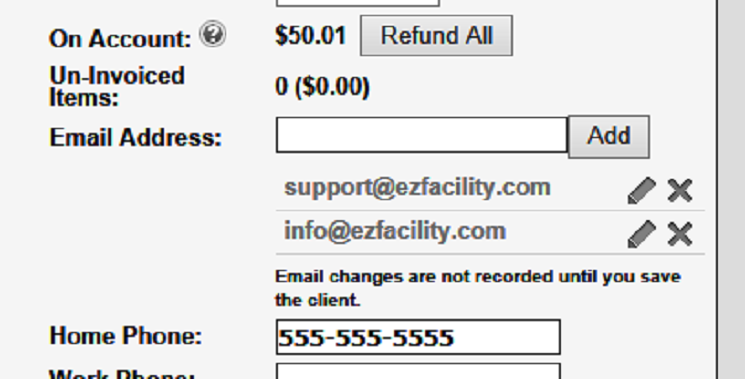
**Remember to click the update button on the client profile to save your changes**
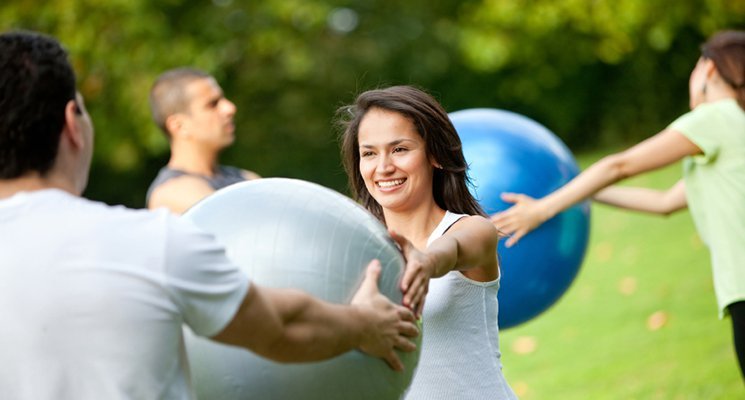
Outdoor Workouts
I don’t know about you, but now that the long winter finally (finally!) seems to be drawing to a close, all I want is to be outdoors. I want that so badly that I almost, for a very brief second — full disclosure — considered letting my gym membership expire. I’ll just start a new one in September, I thought. It was only a fleeting idea; happily, I know that I get too much from my gym to ever really let go of my membership so easily. But a lot of people don’t know that. A lot of people do exactly what I thought of doing: let their membership slide in the warm months and rejoin (or, worse, join somewhere else) when the cold sets in again.
One way for a gym, or any type of fitness or sports center, to combat this phenomenon is to take things outdoors. In recent years, it’s become more of a trend for health clubs to institute outdoor programs. Large cities hold yoga-in-the-sun classes. Gyms offer boot camp in the park. So-called “street workouts” are becoming more popular, with exercisers using poles, park structures, even swing-sets to build up core muscles and practice other forms of strength training.
If you haven’t yet cashed in on the trend, it’s time to do so. Your audience is hungry for it (google “outdoor workouts” and you’ll see what I mean). The question is, how do you make it work? How do you move operations outside?
Start with an existing class — it’s probably your most portable commodity. Go for a low-key class first, one that doesn’t rely on music or heavy equipment. (Once you get things up and running and you understand how to coordinate outdoor sessions smoothly, it’ll be simple enough to fiddle with sound systems and free weights; til then, keep things easy for yourself.) Think of props that naturally work well outside: balls, jump ropes. Get your instructors to incorporate these items and, if necessary, to modify their routines to suit the outdoors. Of course, promote heavily. Your social media channels should be screaming, “New outdoor class!” The walls of your facility should be littered with posters and flyers. Make sure the logistics are clearly communicated: Will the class meet in the gym lobby and then follow the instructor out? Will there be a meeting point in the park? Spell it out.
Once you’ve seen how it works — and what the potential pitfalls are — think of creating classes specifically for nature. Call upon the expertise of your trainers and instructors; find out their favorite outdoor workouts and ask them to develop these into teachable sessions. Scout out potential locations carefully and make use of what’s out there: trees, old jungle gym sets, park benches. Anything fixed to the ground is fair game.
After you’ve built up an outdoor clientele, think about investing in equipment. Life Fitness recently developed a “jungle gym” series for outside; other companies are following suit. If you’re in a location that doesn’t easily allow for outdoor access, consider doing what my gym in New York City does: use the rooftop. You might have to partner with a school, community center, or other organization that already has outdoor space. (If you’re using parks, keep in mind that many municipalities require permits for the use of public spaces, and often there are restrictions about how existing structures, including trees, can be used. Do your homework.)
Follow these steps, and you’ll be well on your way. The only thing left to figure out will be how you can sneak into one of your own facility’s outdoor sessions — because once you have the option, there’s no way you’re going to want to stay inside.
New Year-Round Sports Facility for Naperville, Illinois
Naperville, Illinois, a Chicago suburb ranked the second-best place to live in the United States by Money magazine and the number-one city for early retirement by Kiplinger, soon will acquire a state-of-the-art, all-season sports facility. The facility, to be called the Naperville Sports Yard, will feature two artificial-turf soccer fields, four basketball courts, a 50-meter track with six lanes, concession stands, and a day care center. Proposed for a 17.5-acre site near an office complex, the building will occupy 101,140 square feet.
Patrons will have the opportunity to purchase memberships, but the facility will offer programs for both members and nonmembers. Proposed activities will include basketball, volleyball, track, adult and youth soccer, lacrosse, seven-on-seven touch football, and a paintless paintball game.
“A facility like the one proposed for Naperville has enormous potential to satisfy the entertainment and physical activity demands of an affluent, health-conscious community,” says Eric Willin, COO of EZFacility, a sports facility management software developer in Westbury, New York. “Building such a venue in a city known for its early-retiree population is a strategic move.”
With one more hoop to jump through — final approval from the Naperville City Council — facility planners are waiting for the green light before launching construction, but once approval is obtained, construction is expected to be fast-tracked, and the grand-opening should occur by the end of the year. The corporation proposing the complex also operates Westmont Yard, a nearby 73,000-square-foot facility for indoor sports.
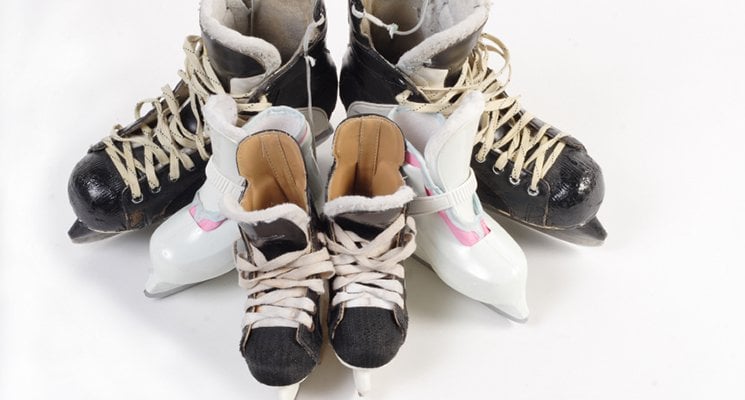
Winter in Summer
Since we seem to be in the middle of an endless winter, let’s contemplate the experience of winter in summer — or, more precisely, how rinks and hockey centers can manage most efficiently in the off-season.
I have a friend who loves to go ice-skating in the summer; rinks are empty, she tells me. But I don’t get it: Why are they empty? Why doesn’t everyone head straight for a field of ice when it’s 95 degrees outside? It’s largely and very simply a matter of public perception, I think: We associate skating and hockey-playing with cold weather, so we don’t think of doing it when summer rolls around. If you operate a rink or hockey center that’s open year-round, however, there are a few things you can do to shift public perception.
It’s all about managing the message. If you offer a summer camp program, get the word out to families before the major push for summer-camp registration starts. These days, parents start signing their kids up for summer activities the day after New Year’s. Luckily for you, that’s the ideal time for a rink to spread the word. At the beginning of December, when you’re in the thick of league games, regular training, clinics, and rink rentals — and before other types of summer programs have easy access to the audience you’re serving — start an advertising campaign for your summer camp program. Put up posters that play on the winter-in-summer contrast, and get creative with them. Images of kids in bathing suits running around in mounds of snow will grab your audience’s attention. Your goal is to let families know that the hockey and skating they’re enjoying so much right now are available to them all year long (and are even more enjoyable when the temperature is soaring!).
Also, if your rink is the kind that converts to non-ice sports in the warmer weather — roller-skating, soccer, field hockey — be sure your customer base knows this. Again, because the tendency will be to associate your facility with winter sports only, customers might think of other venues before they think of yours. From the first moment a hockey player or ice-skater walks through your door, be sure it’s obvious that your activity offerings go far beyond the ice-based. Prominently display pictures of people enjoying other sports in your facility; directly advertise your other offerings. Train your staff members to mention those other offerings at the moment when registration for a winter sport happens.
Finally, make good use of social media. Facebook, Twitter, and especially Instagram and Pinterest are all image-centric: Reveal your full breadth of offerings through vivid images that you post frequently. Avoid the natural inclination to show off only your ice-skaters and hockey-players when the holiday season in upon us, and businesses everywhere are plugging images of happy, winter scenes. That’s the perfect time, in fact, for you to capitalize on the interesting contrast you can offer that other places can’t: winter in summer!
Texas A&M University to Renovate Student Rec Center
Teas A&M University is launching a renovation of its student recreation center in a project expected to total $54 million. The refurbished center, nicknamed “The Rec,” will increase from 300,000 square feet to 413,000 square feet. The overhaul will result in more weight-room space and a two-court gymnasium expansion. New multipurpose activity rooms will be added, with renovations also planned for the Rec’s swimming pools and related equipment and areas.
In addition to the new construction, 56,000 square feet of existing space will be overhauled and a new outdoor plaza will be added, along with a new second entrance and a lighting retrofit. Funding for the project will come from revenue bonds supported by the university’s recreational sports fee.
“A renovation like this is a major undertaking for a university,” says Tracey Keates, President of EZFacility, a Woodbury, New York–based gym management software developer. “It shows a commitment to student health and enjoyment, as well as to state-of-the-art facility operation. It will be exciting to see the final product.”
The university’s recreation center opened in 1995, and this will be the facility’s first major renovation since then. In the ensuing time, Texas A&M’s student body has increased by 25 percent.

Making Sound Decisions
IHRSA’s 2014 33rd Annual International Convention and Trade Show offered up so much food for thought that you’re probably feeling stuffed right about now. But it’s worth really digesting what author Dan Heath had to say in a general session discussion during the event. His talk, “Decisive: How to Make Better Choices in Life and Work” took a close look at the foundation upon which all business are built: decisions. Good decisions can make you; bad ones can break you. How can you be sure you’re making sound decisions?
Heath identified four elements — or, as he calls them, “villains” — of bad decisions: (1) narrow framing, (2) confirmation bias, (3) short-term emotion, and (4) over-confidence. He also offered a strategy for countering each of these villains; he calls it the WRAP strategy.
If you’re framing out an issue too narrowly, you have blinders on; you can’t see the full picture, so you can’t make a sound decision. To counter this villain, use the “W” in “WRAP”: Widen your options. Try to see more than just the two possibilities of making the decision or not making it. If you’re working with a confirmation bias, you’re not gathering enough information before making your decision — you’re seeking reassurance about your preconceived notions rather than the truth about the issue. To counter this one, use the “R”: Reality-test your options. Find a real-world way of testing your options before you make a decision. If you’re relying on short-term emotion, you’re not taking time to think things through. The remedy? “A”: Attain distance before you decide. If you feel emotional about a decision you have to make, give yourself time, or take a step back. You can act more rationally with distance. Finally, there’s the problem of over-confidence. If you’re too confident, you think you know more about what will happen in the future than you really can know. You counter this “villain” with the “P” in “WRAP”: Prepare to be wrong. To make such preparations, you set up what Heath calls a “decision trip-wire,” something that makes you, at some future point, go back, assess the decision you made, and alter or undo it if necessary.
As a gym, health club, fitness center, or sports facility, your business relies on dozens or scores (or more!) of small decisions each day. Do you schedule a cycle class in the morning or the evening, or both? Do you hire a trainer who specializes in HIIT workouts or more of a generalist? Do you purchase Vibration Training machines? White towels or beige ones? And are you going to fire that employee who is slacking off every time you look at him? There are these and so many more, and it can be hard to know what’s right. Having a rubric that helps you know when you might be making a bad decision — and what you can do to turn it into a good one — can be immensely empowering. Heath says his scheme isn’t right for all kinds of decisions, and it might not be right for all businesses or all managers, but thinking about it can help you come up with your own plan. Then you’ll be able to make decisions with confidence (but only just the right amount of it!).

Brand Identity
We all know how confusing a mixed message can be. Somebody tells you one thing and then does another, and you’re left wondering what exactly happened. Did you misunderstand something? Have you misinterpreted? Most of all, can you still trust the person in question?
While it can be bewildering when it happens between individuals, it can be downright damaging when it happens between an individual and a business, especially when the business thrives on retaining members. So, it might be time to review the messages you’re sending your clientele and make sure you’re not putting conflicting signals out there. To that end, a few pieces of advice:
1) Consider your free offers carefully. Some gyms have been known to offer pizza days, bagel days, even doughnut or candy days. While such food giveaways might make members happy, they can undermine your primary messaging. You want your members to believe that you care about their health — sure, a slice of pizza or a bagel once a month never hurt anyone, but let the strip mall down the street supply those. If you do it, how believable are you going to sound when you tell your members they need to exercise and eat properly to lose weight? And if you don’t sound believable and they don’t lose the weight, are they going to renew their membership when the time comes?
Of course, you could give away candy or bagels—even bagels slathered in cream cheese or butter—if you hand out with them, say, a chart that shows how many push-ups a person would need to do to burn off those calories, or how many miles they’d need to run on the treadmill. Again, it’s about consistent messaging.
2) Check how inclusive you’re being. Unless your facility is an elite training center or something similar, chances are you don’t want to turn away any potential clients. Are your flyers, advertisements, social media postings, and other promotional materials inclusive, with people of all colors, genders, sizes, cultures, and ethnic backgrounds represented? Will an overweight person or a Spanish-speaker or a transgender individual feel alienated? Try to consider your messaging from as many different points of view as possible, asking yourself whether you might be unintentionally shutting anyone out.
3) Pay attention to your grammar. I know this one makes me sound like your ninth-grade English teacher, but it’s important. In this day and age, when so much of a company’s identity depends on the words it strings together on Facebook, Twitter, and Instagram, in emails, and on websites, proper grammar—along with careful spelling and punctuation—is crucial. This is especially the case if your messaging is about achieving excellence, pushing yourself, going over and above, and the like. If you want to keep your credibility, you have to show your own willingness to achieve excellence, to push yourself. Even if your clientele cares more about a good workout than a well-crafted sentence, on some level evidence of carelessness will have an effect.
In the end, it’s about having a solid brand identity and continually working to strengthen that identity. Tweaking small details and taking the time to reflect on the messages you’re conveying can make a big difference.

Features & Fixes – Automatic Credit Card Notification Emails
Our Development Team is constantly working to improve your user experience with EZFacility. Between major updates, we release small but important Features and Fixes that address issues and add useful new options/tools to better help you manage your business with EZFacility. These changes are documented in our Release Notes, found in our Community Center under the “Product Info & User Guides” section.
Have you ever tried to process a customer’s monthly membership or package renewal only to be declined due to an expired credit card? An expired card can lead to lost revenue and wasted staff hours as necessary follow-ups must ensue to acquire updated billing information. EZFacility’s Development Team has released a brand new feature that focuses on eliminating this all-too-frequent scenario – Automatic Credit Card Notification Emails.
Automatic Credit Card Notification Emails
In the Billing Preferences page, you can now choose if and when customers are notified that their credit card on file is about to expire. First, enable these notifications, so that the system knows to start sending these reminders on your behalf. Then choose whether the system should send notifications 60 days before expiration, 30 days before expiration, or on both days. Lastly, select whether these notifications are to go to everyone with cards on file, or just those who use their credit cards for Autopay.
Please note, credit cards saved on file are set to “Use for Auto Pay” by default and can only be changed if your account is setup to use direct debit.
And More!
In addition to these changes, there were many additional updates included in this release. For more details, please visit our Release Notes page.
Major Field Renovation Planned for Big Ten School
The University of Michigan recently announced an $8 million plan to renovate Mitchell Field, its main outdoor athletics area. Consisting primarily of a general field and a softball field, the area will undergo a complete overhaul, with artificial turf replacing the existing lawn.
Mitchell Field averages 800 users an evening when intramural and club sports are in session, according to the University of Michigan. Rugby, flag football, ultimate Frisbee, and other sports all take place on the field, which was built in 1981. The university hopes the new artificial turf will increase usage flexibility, growing the field’s capacity and extending its operating hours and operating season.
The renovation is part of a $173 million plan to renovate the university’s unions, gyms, and athletic fields. Funding will come in part from an approved uptick in student fees.
“Athletic facilities at large universities, especially at a Big Ten school, serve a huge demand,” notes Eric Willin, COO of EZFacility, a sports facility management software developer in Woodbury, New York. “Overhauls of this magnitude are occasionally necessary. The end result no doubt will allow for better water drainage, minimal field closures, and a great deal more usage.”
In addition to upgrading the field, the university will erect fences and install new lighting. The existing field house will be converted to a storage center. Ultimately, the university aims to build a new 3,200-square-foot building that holds bathrooms, on-site maintenance, and operational support.
David Barton Gym To Be Featured on Popular Reality TV Show
The New York-based health club David Barton Gym will take the spotlight on Friday, March 14, as the featured employer on Inside Job, a new reality television series on the TNT network. The show sets four people together in the same living space for five consecutive days, then pits them against each other as they compete for a six-figure job at a large company. One of the four is already an employee of the company; he or she secretly reports back to a high-level executive about the three actual candidates. The end of the show reveals the candidate chosen for the job.
Howard Brodsky, David Barton Gym’s CEO, told Club Industry magazine, “I felt this was an unparalleled opportunity to give viewers an inside look at what makes David Barton Gym the most unique in the country.”
“A gym is a natural choice for the setting or subject of a reality television show,” says Emily Wilensky, Marketing Manager of EZFacility, a gym management software developer in Woodbury, New York. “There’s constant motion, a natural atmosphere of intensity, and, because people at gyms generally are working hard toward personal goals, good potential for drama. From the gym’s point of view, it’s a great way to increase awareness of and interest in your brand.”
Several years ago, the Los Angeles-based Sky Sport and Spa was featured in the Bravo show Work Out. More recently, Retro Fitness had a spot on Undercover Boss. Generally, fitness and the issues surrounding it play a big role in reality TV, with shows like The Biggest Loser, Toned Up, and Fight Girls consistently ranking among some of the most popular reality TV series.
For the Inside Job episode featuring David Barton Gym, participants had to meet two challenges to prove themselves worthy of the job the gym was looking to fill, social media director. In the first challenge, they had to design a new fitness class at the gym’s West Lost Angeles branch and market and lead the class for nonmembers. In the second, they had to work with a graffiti artist to develop a mural on the Venice Beach boardwalk that communicated the David Barton brand and then turn the mural into a social media event.

FDA’s New Nutrition Labels
For twenty years, Americans have known that if they want information about a food product’s nutritional content, they can check the label. Recently, the U.S. Food and Drug Administration (FDA) proposed a change to the labels we’ve grown used to. The government organization wants to replace out-of-date serving sizes; highlight certain parts of the label, such as calories and serving sizes; and include information about nutrients some consumers aren’t getting enough of, like Vitamin D and potassium. “To remain relevant,” explained FDA Commissioner Margaret A. Hamburg, M.D., “the FDA’s newly proposed nutrition facts label incorporates the latest in nutrition science as more has been learned about the connection between what we eat and the development of serious chronic diseases impacting millions of Americans.”
First, bravo FDA. It isn’t always the case that policies and laws are revised to accommodate findings from new research. Given what we know about nutrition and chronic disease that we didn’t know twenty years ago, the proposed new label has the potential to help improve the health of a great number of people.
Second, now’s your chance, health clubs and sports centers. You are better positioned than most other institutions to educate the public about the proposed new labels, and to use the FDA’s new nutrition labels as a way to boost your visibility and desirability. By being among the first to spread the news about the labels, and by linking the news to your own programs and offerings, you’ll remain relevant to your clientele in a way that can work only to your benefit.
As a fitness center, gym, health club, or sports facility, you probably already spend some time and other resources on keeping your members and clients informed about nutrition. (If you don’t, what are you waiting for? If people don’t get such information from you, they’ll get it from elsewhere. If you provide it, you have an immediate way of establishing how essential your facility is to health maintenance — along with how generously you provide value-added services.) There are many ways you can teach your clientele about the proposed new labels. Search FDA’s website for an example, and blow it up to poster size for prominent display somewhere in the gym. Invite people to speak with resident nutritional experts or trainers about the changes. Host a lecture by a nutrition advisor who can explain the changes and their significance. Invite the general public to the lecture as well as members — what better opportunity for attracting new members? Have instructors take a few minutes at the beginning or end of class sessions to explain and describe the new labels.
The goals here are to make yourself the source of the information, get a dialogue going within your four walls, emphasize your facility’s commitment to clients’ health, and prove yourself a dedicated member of a larger community. In the past, fitness centers and sports facilities were not expected to do much more than provide a place for a good workout or league game. The FDA is keeping up with changing times; make sure that you are too.

The Benefit Is Clear
With one of the fitness industry’s central players — IHRSA — priming for its annual convention and trade show in a couple weeks, it’s worth taking a moment to consider the general benefits of attending such events. For companies selling machinery, equipment, gear, software, and other products, the benefit is clear: Easy access to many potential customers at one time.
What about for health club or sports facility owners and managers? What’s in it for you? Is it worth the investment of time and participation fees?
In a word, yes. Attending a convention and/or trade show is beneficial to facility owners first and foremost because of the opportunity to connect with others in the industry. Sure, they may be competitors, but the old saying holds true: Keep your friends close and your enemies closer. Your competitors, other clubs in your industry, are the ones from whom you have something to learn. Happily, participants who choose to attend events like conventions generally do so with an open attitude: They’re there to share. Through casual conversation, over meals and beverages, by chance meetings and introductions, ideas are transferred and transformed. Want to know how the gym down the street handles retention issues? Want to understand why that other baseball center is so successful at attracting new customers? Here’s your chance to find out.
Also, those guys out on the floor trying to sell you stuff? They’re not just looking to fill their pockets. Most of them attend with ideals of relationship-building in mind. They really want the opportunity to meet you, get to know you, understand your needs and desires as a customer. From their point of view, the better they know you the better they can serve you — and the better they can serve you, the better off you are. And it’s a lot easier for a salesperson to cut a deal for someone with whom he or she has a personal connection than for a stranger.
Finally, there’s the whole pay-it-forward idea. As a business owner or manager, and specifically as the business owner or manager of a fitness or sports facility, you’re part of a community. Even if it’s easy to forget for most of the year, conventions and trade shows can serve to remind you that the difficult work you do is the same as the difficult work others do. And just as you can gain ideas and tips from other facility folk you meet at such events, other facility folk can gain ideas and tips from you. You might even seek to take part in a panel or give a talk — because business, as you no doubt know, is as much about giving as it is about receiving. There is no better opportunity for giving than to share what you know, what your best practices are, and how you meet day-to-day demands than at a large gathering where so many industry-mates are all at once. You might not see immediate returns, but eventually your paying it forward will pay off. In tangible and intangible ways, you’ll feel the benefits of having been part of it all.

